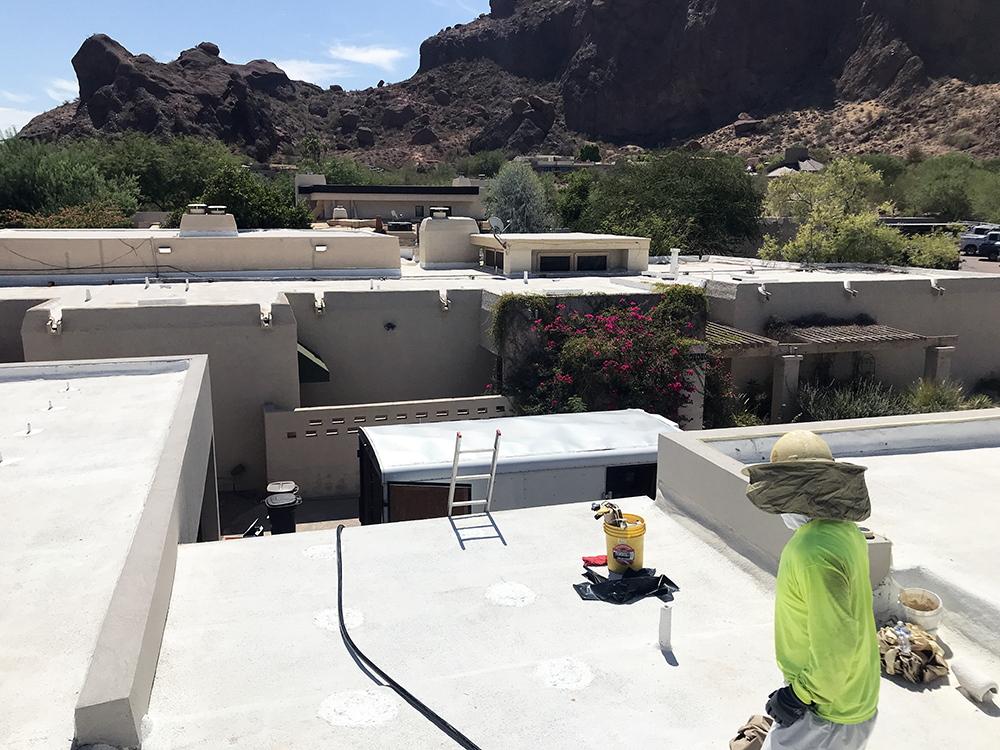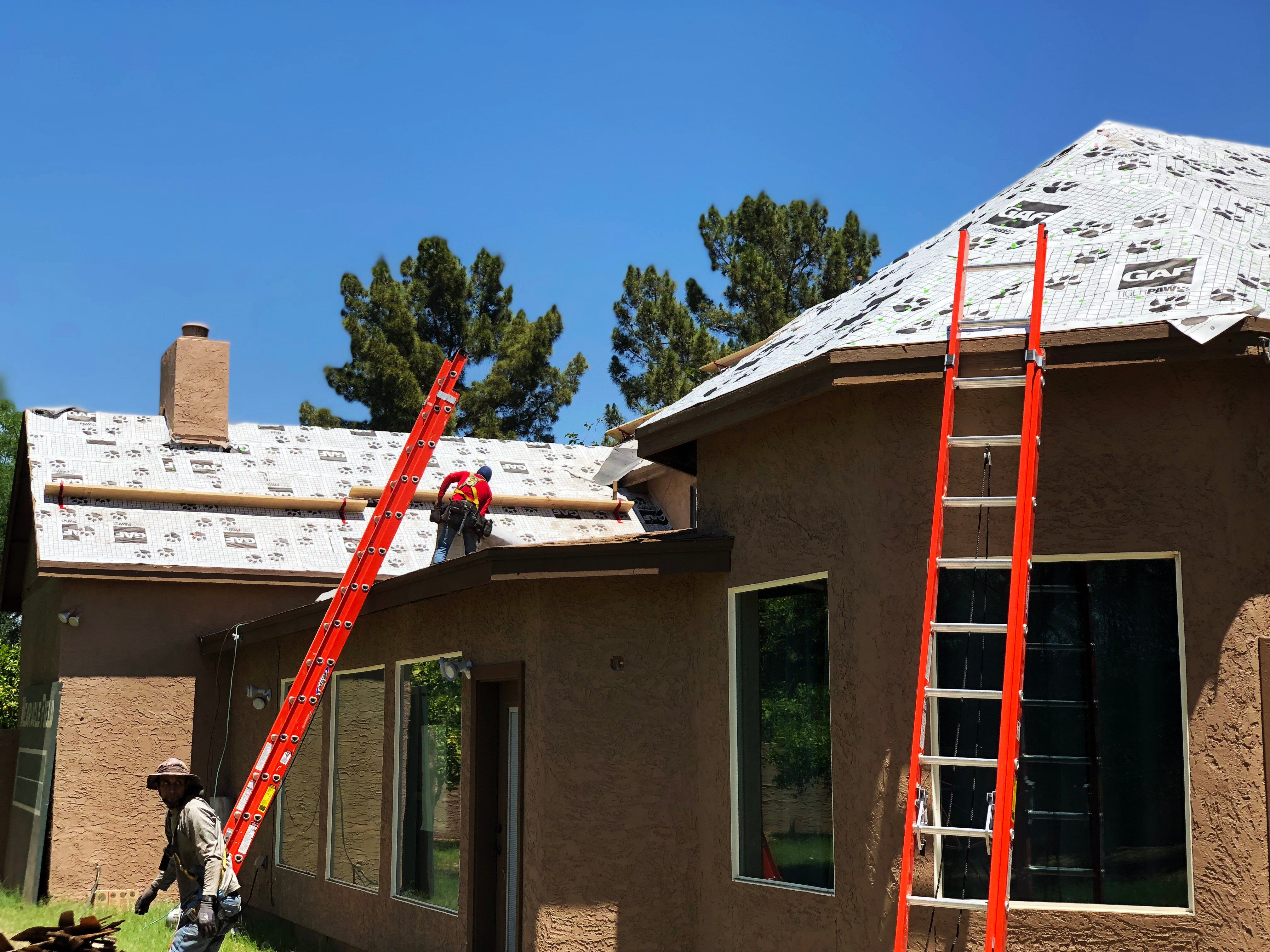Roof Underlayment 101: What It Is & Why It’s Important
Home / Azul Blog / Roof Underlayment 101: What It Is & Why It’s Important When most homeowners think about their roof, they picture the tiles, shingles, or foam that cover the top...

Our southwest-inspired architecture frequently incorporates flat roofs, making this a familiar roofing type to find here in the Valley of the Sun. While flat roofs are more common with commercial buildings, we have seen more homeowners choose this type of roof in their new builds. We'd hazard a guess that this is in part because of the many benefits flat roofs offer.
From streamlined repair and maintenance jobs to quicker installations, flat roofs come with great perks. In our blog below, we'll review these benefits you can expect to reap from your flat roof and also a few cons to be aware of before you select this type of roof for your home or business.
There are four main types of flat roofs: Built-up roof, modified bitumen, spray polyurethane foam, and rubber membrane roof.
A built-up roof is a more traditional hot tar and gravel roof. It's constructed with layers of waterproof material and hot tar. This type of roof has come a long way from its inception and now are frequently created with fiberglass membranes instead of tar paper.
This variety of flat roof is considered a "cousin" of the built-up roof. It consists of asphalt rolls around 3 feet wide of five layers, including insulation, modified base sheets or plies, modified bitumen membranes, adhesive, and surfacing. Some modified bitumen and BUR roofs can have acrylic or silicone coatings applied to extend the life of the roof.
As the name implies, the roof begins with a layer of polyurethane foam, which is then coated with some type of waterproofing elastomeric top coat. The top coat is typically UV reflective, which can help keep heat out during the summer. Every 1” of SPF has approximately an r-6.5 insulation value, which indicates how much the material can resist heat flow. Typical homes will have 1” of foam applied.
Rubber membrane roofs are typically made from synthetic rubber, thermoplastic, or modified bitumen. Thermoplastic polyolefin (TPO) is one of the best types of rubber roofs in Arizona due to its heat-reflective and energy-efficient nature. While more common on commercial roofs, TPO roofs are growing in popularity in the residential sector as well.
Each 1” of poly-iso foam has approximately r-6.8 but can diminish with age. Typical homes will have 1-1.5” of poly-iso foam, while some commercial buildings may have up to 6” of poly-iso foam.
Flat roofs offer many advantages to both homeowners and business owners alike. Some of the biggest pros are the cost of flat roofs and the easier maintenance and installation.
Flat roofs easier to maintain than their pitched counterparts. It's a simpler process to check sidings or fill in holes on a flat roof where you're not worried about falling off a pitched roof. Properly maintained SPF roofs can last 30+ years!
Due to the streamlined nature of a flat roofing system, installing a new roof is a quicker process than on a pitched roof. You won't have as much downtime waiting for your new roof to be installed. Most flat roof jobs can be completed within a day, so there's no need to clear a large portion of your schedule just for roofing work.
Many homeowners and businesses alike turn their flat roof into extra useable space, depending on how easy it is to access. If you're a homeowner, you can think of turning this area into an additional patio or rooftop garden. For businesses, flat roofs can be a great place to hide extra equipment if structural integrity permits.
Although flat roofs come with many advantages, there are also some cons to be aware of when considering this type of roof.
Since there's no attic beneath a flat roof, there's not very much room for insulation. Because of this, flat roofs can be more susceptive to major swings in the outside temperature. If you choose a foam roof, however, you can select a UV coating that will help reflect some of the heat and control the temperature during our hot Arizona summers.
While flat roofs can fit in relatively well with our southwestern architecture, not everyone finds them aesthetically pleasing. This can be a significant detractor for someone weighing the pros and cons between a flat roof and a pitched roof, especially if a flat roof doesn't fit in as well in their neighborhood.
Although flat roofs are easier to replace and maintain, their lifespan isn't as long as a pitched roof. A typical flat roof lifespan is between 10-15 years before they have to be replaced or 5-7 years before they have to be recoated. A pitched roof can get between 25-50 depending on the roofing materials and maintenance.
Our roofing professionals at Azul Roofing Solutions have years of experience with flat roofs. If you're interested in a free, no-obligation roof inspection, click the button below to get your roofing project started today.
Flat roofs offer easier maintenance, quicker installations, opportunities to convert the roof into usable outdoor space like patios or rooftop gardens, and streamlined repair jobs.
A well-maintained SPF roof can last 30+ years, though many flat roofs need recoating or replacement every 10-15 years depending on material and upkeep.
Flat roofs usually lack an attic space, so there’s less room for insulation. This can make them more susceptible to temperature swings unless you choose foam roofs with UV reflective coatings to mitigate heat.
Flat roofs generally have shorter lifespans: 10-15 years before replacement or 5-7 years before recoating is needed. Pitched roofs can often last 25-50 years, depending on material and maintenance.
Yes, if structural integrity allows, flat roofs can be used as extra outdoor living space or rooftop decks—offering homeowners more usable area.
They’re generally easier to install and maintain. Fewer complications with slope means less risk of safety issues, and many maintenance tasks are simpler. However, the trade-off is more frequent upkeep like coatings and potential insulation or heat management issues.

Home / Azul Blog / Roof Underlayment 101: What It Is & Why It’s Important When most homeowners think about their roof, they picture the tiles, shingles, or foam that cover the top...